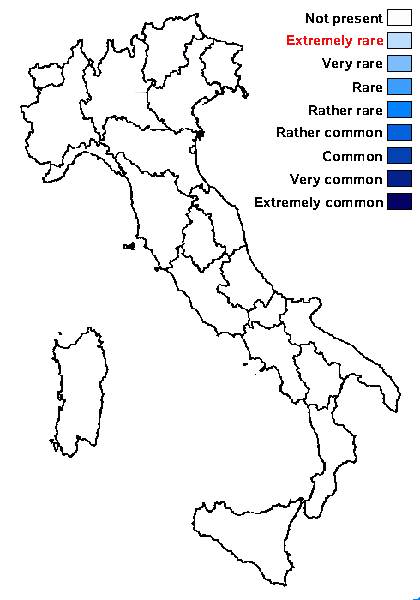Arthonia pleopsidii E.Zimm. & F.Berger
Herzogia, 38,1: 54, 2025.
Synonyms:
Distribution:
Description: Thallus inapparent, not lichenized developing on the hymenia and thalli of Pleopsidium chlorophanum, the infection starting beneath the epithecium of the host in the form of dark green to olive spots, later the infected parts (including the thallus) turning jet black. Apothecia arthonioid, dispersed, olive-black to black, round or irregular in outline, at first immersed, later superficial, with a slightly convex, 0.1- 0.3 mm wide disc, without a distinct margin. Proper exciple not developed; epithecium dark green to olive-green, 10-18 μm high, K+ intensifying, N-; hymenium colourless, (35-)50-60 μm high, I+ wine-red, K/I+ blue; paraphysoids c. 2 μm, thick, richly branched and bending over the asci in upper part, the apical cells swollen, 4-5 μm wide, the walls with olive-green to bluish black pigments, K–; subhymenium colourless, c. 15-30 μm high; hypothecium colourless, c. 30-50 μm high. Asci 8-spored, broadly clavate, the tholus thick, with an ocular chamber, without a K/I+ blue apical ring, the ascus gel K/I+ orange. Ascospores 1-septate, not constricted at septum, ellipsoid, hyaline, (12-)13-15(-16) x 5-6(-6.5) μm. Pycnidia 55-60 μm across, the wall colourless at base, dark green in upper part, with a crown of olive, elongated cells around the ostiole, the conidiogenous cells slender, cylindrical, c. 8 x 2 μm. Conidia hyaline, bacilliform to slightly curved, 6-7 x 1-1.4 μm. Photobiont absent. Spot tests: all negative. Chemistry: without lichen substances.Note: a recently-described lichenicolous fungus developing in the apothecia and thalli of Pleopsidium chlorophanum, hitherto known from a few localities in the Austrian and Swiss Alps, in the subalpine to alpine belts, on very hard siliceous, vertical walls and overhanging boulders, between 1685 and 2500 m. For further detalis see Berger & Zimmermann (2025). To be looked for in the Italian Alps.
Growth form: Lichenicolous fungus
Substrata: rocks
Photobiont: green algae other than Trentepohlia
Reproductive strategy: mainly sexual
In underhangs rarely wetted by rain

Predictive model

Photo by E. Zimmermann. -Source: Berger F., Zimmermann E. 2025. Contribution to the knowledge of the lichenicolous mycobiota of the Alps II. – Six new species from Austria and Switzerland. Herzogia, 38, 1: 51- 69. Courtesy of the authors
Infection on young thallus of Pleopsidium chlorophanum, associated with Epicladonia lapponica (hb Zi 4439). - Scale bar: 0.5 mm
Growth form: Lichenicolous fungus
Substrata: rocks
Photobiont: green algae other than Trentepohlia
Reproductive strategy: mainly sexual
In underhangs rarely wetted by rain

Predictive model


